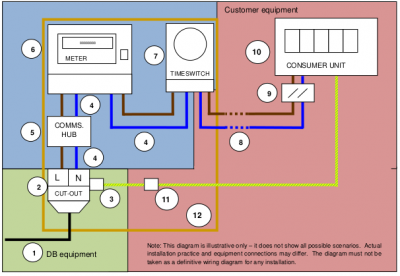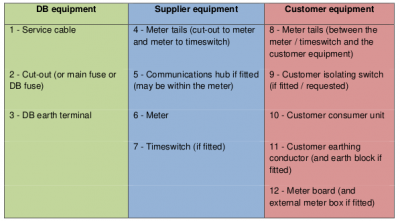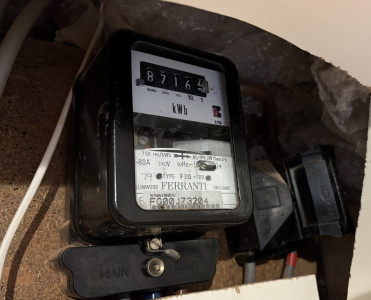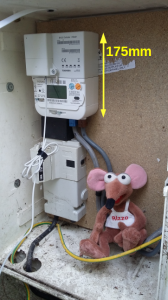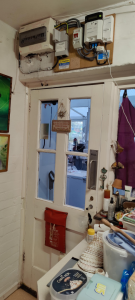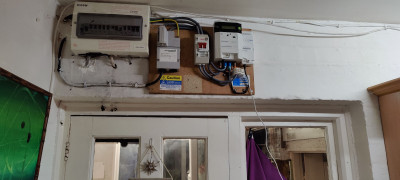@transparent wow, that sounds like a lot of steps and work. Can we request them to move the meter? Ours is in a stupid location. Can they place it in or near the consumer box?
Get a copy of The Ultimate Guide to Heat Pumps
Subscribe and follow our YouTube channel!
Posted by: @transparentYour Consumer Meter will be checked for compliance before being switched off.
What does that mean?
Get a copy of The Ultimate Guide to Heat Pumps
Subscribe and follow our YouTube channel!
Posted by: @editorCan we request them to move the meter? Ours is in a stupid location. Can they place it in or near the consumer box?
The Meter and the Service Fuse (aka 'Cutout') are screwed to a backboard which is the property of your DNO.
This diagram is taken from the Meter Operators Code of Practice (MOCOPA) guide. The backboard is the orange rectangle which surrounds the equipment in the green and blue sections:
You can arrange for relocating the Service Fuse position by applying to your DNO:
This link takes you to the relevant page for NGED licence areas.
But I don't know if they're your DNO: https://connections.nationalgrid.co.uk/make-a-change/move-equipment/move-my-electricity-supply-service-alterations/
What charges might or might not apply depend on the supply cable.
Shortening it is obviously much easier than extending or replacing it!
They will probably be delighted if this can coincide with fitting a Smart Meter. 😀
That same MOCOPA Guide contains photographs and descriptions of the categories of possible faults with the mains incomer.
Most of us here on this Forum should be aware of what constitutes a 'safe' connection and Service Fuse.
The Guide allows us to define that with the relevant fault code and get it reported to the DNO.
I strongly recommend you download a copy and keep it on your PC.
The document tends to get moved around, and was missing entirely from the RECC Digital Library for almost a year!
The Consumer Unit checks are fairly obvious ones.
Installers won't be happy to reconnect a new meter to a Consumer Unit which doesn't satisfy the IET Regulations.
- Is there a double-pole Switch Disconnector where the 'tails' enter the enclosure?
- Is there an earth for the property which matches the type of supply? (PME supplies use an earth derived from the Neutral)
- Are the house circuits appropriately fitted with trips/fuses?
- Are the wires double-insulated all the way into the enclosure? (no brown or blue inner wires must be visible)
If not, then get these issues sorted by a local electrician first.
A Smart Meter installation is recorded as a series of Notes, accompanied by photographs taken by the installer.
There is no room for him/her to accept your assurance that you'll 'get that fixed next week'!
Please keep asking the questions...
... they'll be the same as everyone else wants to know about!
Save energy... recycle electrons!
Apologies, that link to the Meter Operators Code of Conduct is failing.
I've logged into the REC to find out why, and the Change Log reports that they've recently decided to reject it!
I really don't understand why this should be the case.
Surely the whole point of RECC having a mandate to operate a digital library of all energy-related documents is that it must retain an archive of every document which has been issued, including all versions/editions/releases. That allows us to see the regulatory framework which under-pinned operation of the energy supply systems at any point in time.
I've found another copy of the MOCOPA Guide PDF here.
Please download it before the site host realises it's meant to have been withdrawn!
@editor - can we host this document somewhere ourselves?
Save energy... recycle electrons!
Get a copy of The Ultimate Guide to Heat Pumps
Subscribe and follow our YouTube channel!
So, the smart meter installer came by today. Our meter is located in a kitchen cupboard that had been ‘boarded up’ by the previous owners. We dismantled as much as we could to expose it fully and finally got a proper look at the meter. Within two minutes of assessing the situation, the installer declared it wasn’t possible to fit the smart meter. He advised us to contact Scottish Power (our DNO) to have the meter moved to a more accessible location. He claimed he couldn’t unscrew the fuse and replace the meter because the smart meter is supposedly much larger than our old relic of a Ferranti, which I found hard to believe.
Coincidentally, we had an electrician over today for another job (easily the best tradesperson we’ve dealt with since moving here – he’s on speed dial now). When we showed him the meter, he was genuinely baffled as to why the smart meter installation hadn’t gone ahead.
The whole experience felt bizarre. There was zero effort to explore options or think creatively about how to install the smart meter. So we’ll be sticking with our old-school Ferranti meter.
Get a copy of The Ultimate Guide to Heat Pumps
Subscribe and follow our YouTube channel!
The height of a Smart Meter is 175mm including the Communications Hub.
It will need at least 60mm below it to accommodate the bend in the tails.
Yours is an unusual Service Fuse.
The neutral is more commonly on the right, and the fuse-carrier on the left.
Have you checked your current arrangement against the possible fault-codes in the MOCOPA Guide?
Have a look at Code A19 (Plastic Cut Out) for example.
Save energy... recycle electrons!
@editor I've just spoken to Octopus about a smart meter and they have requested a photo as they say they can't work on a meter that is over 7.2 feet above the floor!! my ceiling is 7.8 feet above floor so I guess they may refuse. This will be interesting as the heat pump will, I believe, require a small new consumer unit beside the board. Perhaps I could build a 1 foot high platform for them. 🤔
Daikin 6Kw ASHP.
MG4 EV
1926 Semi with loft and wall cavity insulation, all radiator.
Oh well they say they will do it. Phew.
Daikin 6Kw ASHP.
MG4 EV
1926 Semi with loft and wall cavity insulation, all radiator.
The board on which you have the Service Fuse and Meter shouldn't be used for other equipment.
I don't see how a separate (small) consumer unit could be placed there for the heat pump.
Are Octopus also going to install that?
If you post another photo showing the front view of the existing array above that door then I might be able to suggest a workaround.
Try to make sure we can see from the wall on the left all the way across to the edge of the board with the existing meter on it.
Save energy... recycle electrons!
Thanks I am glad of your input so I am able to make suggestions if asked.
About two years ago the main feed was replaced by Western Power ( I think?) and they replaced a socket (the pale square) that I used to check my meters Zs. I removed it as I don't need it now and realised it should not be on their board.
Yes Octopus are installing the ASHP, and hopefully the meter.
Their experienced surveyor ( who told me he was from an IT background!!) said they would put a new CU to the Right of the board. I hope when the actual installer arrives we can make sense of it all.
Daikin 6Kw ASHP.
MG4 EV
1926 Semi with loft and wall cavity insulation, all radiator.
That's a very useful photo @jancold
It provides me with heaps of issues which need a comment!
1: The "new" Service Fuse must've been installed by Western Power Distribution (WPD) before Sept'22.
That was when they formally started operating as National Grid Electricity Distribution (NGED).
You have a PME supply to the house, which means that the earth is provided by the DNO, rather than the house having its own earth-stake in the ground.
The green/yellow wire emerging from the top-right of the Service Fuse is where it is connected to the Neutral wire from your local substation.
2: The incomer enters through the plaster of the wall to the left of the consumer unit.
It then has to run beneath the consumer unit to get to the Service Fuse.
I can't tell if the incomer wire is 25mm² or 16mm².
But if NGED are involved at all in the changes which are about to be made, then they will downgrade your Service Fuse to 80A.
This is an engineering/technical decision, and there is good reasoning behind it.
Think of the high-current devices in your home.
These might be:
- EV Charger (32A)
- Electric Shower (40A)
- Heat Pump (8A operating, but as much as 30A every time it starts)
- Storage Battery (perhaps 20A when recharging from the grid)
- Immersion Heater or Kettle (3kW, which is 12A)
If these were running simultaneously an 80A fuse would still allow that high current for several minutes because it's a slow-blow fuse.
But because all of these loads are supplied from the same phase, there would be unacceptably high losses at the substation transformer.
Phase-imbalance results in energy being lost as heat.
The correct way to address this issue is for the house to be upgraded to a 3-phase supply.
NGED would not usually charge you for this, but it needs a discussion.
Your electrician would then fit a 3-phase consumer unit (or three consumer units each fed from a different phase).
He/She must then spread your high current loads across these phases.
That requires a conversation with you to understand how the home operates.
For example, you might never use an electric shower at the same time as an EV Charger.
3: Installing a new consumer unit to the wall on the right of the meter board isn't as easy as you might suppose.
Your existing 12 + 2 module box is full, and could do with some space to be freed up for earth-leakage trips (RCD or RCBO) in addition to just MCBs which detect over-current.
If this new consumer unit were to take over some existing circuits, then there are cables entering the consumer unit which won't 'stretch'!
In particular I can see a Steel-Wire Armoured (SWA) cable leaving the consumer unit at top-left.
I don't know what it supplies, or whether it should have a residual current device (RCD) for safety.
Another alternative is to replace the entire consumer unit with a larger one which has space for more trips.
If this were to be mounted on battens, bringing it forward of the wall, then it could sit in front of existing cables.
Electricians like boxes to have a 'void' behind them because it allows for easier cable entries.
The SWA cable would then enter at the rear of the enclosure rather than via a sharp bend at the side.
There are a number of alternative ways to address these 'problems';
None of them is insurmountable.
Let me stop at this point and hear what you think.
I should also tell you that I have access to NGEDs network maps and transformer data.
So if we need to find out how much spare capacity there is, then I can do that in less than a minute.
But please don't post your address here on the open forum.
Save energy... recycle electrons!
- 26 Forums
- 2,364 Topics
- 53.6 K Posts
- 271 Online
- 6,027 Members
Join Us!
Worth Watching
Latest Posts
-
RE: Mitsubishi Ecodan R290 10kW performance
I have CN105 'dongle' connected to my system, which I'd...
By Sheriff Fatman , 12 minutes ago
-
RE: Solis S6-EH1P8K-L-PLUS – Why I Chose It and What I’ve Learned So Far
I've been looking at the S6-EH1P8K-L-PLUS, but put off ...
By energy9165 , 18 minutes ago
-

We also have angle-topped bay windows and have decided ...
By downfield , 21 minutes ago
-
RE: Speedcomfort radiator fans
Too expensive IMHO for a whole house, at this point do ...
By JamesPa , 31 minutes ago
-
RE: New Fogstar 15.5kWh upright solution
@transparent The readings are 0 for amps, 0 ...
By Batpred , 12 hours ago
-

RE: Say hello and introduce yourself
@velcro welcome to the forums. Please feel free start a...
By Mars , 13 hours ago
-
Daikin EDLA11D3V3 DHW Settings
I have a newly installed EDLA11D3V3 which I'm still get...
By Velcro , 14 hours ago
-

RE: Setback savings - fact or fiction?
Will come back to the above points, but for now, I've j...
By cathodeRay , 14 hours ago
-

@jamespa I have found that it comes as a shock when we ...
By Toodles , 16 hours ago
-
RE: My Powerwall 3 Consumes 3-4 kWh/Day in Self-Consumption: Is This Normal?
I suspect a good chunk of the "losses" are power consum...
By Bash , 17 hours ago
-

RE: Need Help Optimising My Rushed ECO4 Install: 12kW Bosch Heat Pump
Hi @mickamills . Welcome to the forum. It sounds like...
By bontwoody , 18 hours ago
-
RE: Midea ASHP – how to set weather compensation
@curlykatie did you get sorted with this?
By MickaMills , 18 hours ago
-

RE: External pipework insulation
@transparent I hope you are not being admonished @trans...
By Toodles , 18 hours ago
-
RE: Octopus Cosy Heat Pump Owners & Discussion Thread
The FT levels off at either the set point OR the minimu...
By AndrewJ , 2 days ago
-
RE: MyVaillant Connect Regular Disconnect
Thanks. Yes, if the time is consistently 11pm every nig...
By buckwem , 2 days ago
-
RE: Who's your electricity provider and what's your tariff?
@transparent Thanks, this helps. Could it be that St...
By Batpred , 2 days ago
-
RE: Clivet ASHPs and weather compensation
Simon did share a lot of very helpful advice. On furthe...
By ambris , 2 days ago
-


